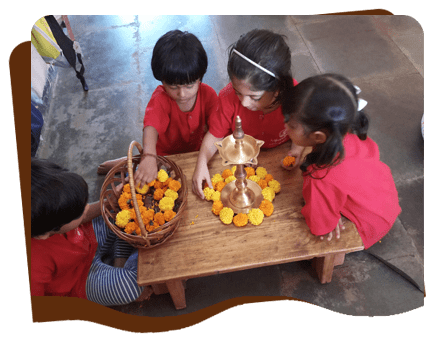“Waldorf education places the development of the individual child in the focal point, convinced that the healthy individual is a prerequisite for a healthy society”. —The International Conference on Education of the United Nations Educational and Scientific Cultural Organization (UNESCO)
Waldorf Education . . . An Introduction
by Henry Barnes
When children relate what they learn to their own experience, they are interested and alive, and what they learn becomes their own. Waldorf schools are designed to foster this kind of learning. Waldorf education has its roots in the spiritual-scientific research of the Austrian scientist and thinker Rudolf Steiner (1861–1925).
According to Steiner’s philosophy, man is a threefold being of spirit, soul, and body whose capacities unfold in three developmental stages on the path to adulthood: early childhood, middle childhood, and adolescence.
Early Childhood
Infants and young children are entirely given over to their physical surroundings; they absorb the world primarily through their senses and respond in the most active mode of knowing: imitation. Imitation is the power to identify oneself with one’s immediate environment through one’s active will. Everything—anger, love, joy, hate, intelligence, stupidity—speaks to the infant through the tone of voice, the physical touch, bodily gesture, light, darkness, color, harmony, and disharmony. These influences are absorbed by the still malleable physical organism and affect the body for a lifetime.
The nursery-kindergarten children play while cooking, they dress up and become mothers and fathers, kings and queens; they sing, paint and colour. Through songs and poems they learn to enjoy language; they learn to play together, hear stories, see puppet shows, bake bread, make soup, model beeswax, and build houses out of boxes, sheets and boards. To become fully engaged in such work is the child’s best preparation for life. It builds powers of concentration, interest, and a lifelong love of learning.


Middle Childhood
When children are ready to leave kindergarten and enter first grade, they are eager to explore the whole world of experience for the second time. Before, they identified with it and imitated it; now, at a more conscious level, they are ready to know it again, by means of the imagination—that extraordinary power of human cognition—that allows us to “see” a picture, “hear” a story, and “divine” meanings within appearances.
During the elementary school years, the educator’s task is to transform all that the child needs to know about the world into the language of the imagination, a language that is as accurate and as responsible to reality as intellectual analysis is in the adult. The wealth of an earlier, less intellectual age— folk tales, legends, and mythologies, which speak truth in parables and pictures— becomes the teacher’s inexhaustible treasure house. When seen through the lens of the imagination, nature, the world of numbers, mathematics, geometrical form, and the practical work of the world are food and drink to the soul of the child. The elementary years are the time for educating the “feeling intelligence.”
Adolescence
Throughout the glorious turbulence of adolescence, the personality celebrates its independence and seeks to explore the world once again in a new way. Within, the young person, the human being to whom the years of education have been directed, is quietly maturing. Eventually, the individual will emerge. In Steiner’s view, this essential being is neither the product of inheritance nor of the environment; it is a manifestation of the spirit. The ground on which it walks and into which it sinks its roots is the intelligence that has ripened out of the matrix of will and feeling into clear, experienced thought. In traditional wisdom, it is this being who “comes of age” around age 21 and is then ready to take up the real task of education—self-education—which distinguishes the adult from the adolescent.
Waldorf at Kalpavruksha
As Waldorf School provides an education that addresses the whole human being—a being of body, soul and spirit. In everything we do, we strive to nourish and develop our students’ thinking, feeling, and willing through an education of the head, heart, and hands. At Kalpavruksha we nurture students’ intellects by developing their capacities for critical thinking and creativity, observation and discernment, imagination and problem-solving. We nurture students’ hearts by fostering kindness and courtesy, respect for others and the world, integrity and the courage to act according to one’s convictions.


